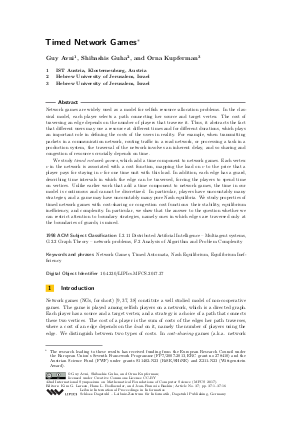Timed Network Games
Authors Guy Avni, Shibashis Guha, Orna Kupferman
-
Part of:
Volume:
42nd International Symposium on Mathematical Foundations of Computer Science (MFCS 2017)
Part of: Series: Leibniz International Proceedings in Informatics (LIPIcs)
Part of: Conference: Mathematical Foundations of Computer Science (MFCS) - License:
 Creative Commons Attribution 3.0 Unported license
Creative Commons Attribution 3.0 Unported license
- Publication Date: 2017-12-01
File

PDF
LIPIcs.MFCS.2017.37.pdf
- Filesize: 487 kB
- 16 pages
Document Identifiers
Subject Classification
Keywords
- Network Games
- Timed Automata
- Nash Equilibrium
- Equilibrium Inefficiency
Metrics
- Access Statistics
-
Total Accesses (updated on a weekly basis)
0PDF Downloads0Metadata Views
Abstract
Network games are widely used as a model for selfish resource-allocation problems. In the classical model, each player selects a path connecting her source and target vertex. The cost of traversing an edge depends on the number of players that traverse it. Thus, it abstracts the fact that different users may use a resource at different times and for different durations, which plays an important role in defining the costs of the users in reality. For example, when transmitting packets in a communication network, routing traffic in a road network, or processing a task in a production system, the traversal of the network involves an inherent delay, and so sharing and congestion of resources crucially depends on time. We study timed network games, which add a time component to network games. Each vertex v in the network is associated with a cost function, mapping the load on v to the price that a player pays for staying in v for one time unit with this load. In addition, each edge has a guard, describing time intervals in which the edge can be traversed, forcing the players to spend time on vertices. Unlike earlier work that add a time component to network games, the time in our model is continuous and cannot be discretized. In particular, players have uncountably many strategies, and a game may have uncountably many pure Nash equilibria. We study properties of timed network games with cost-sharing or congestion cost functions: their stability, equilibrium inefficiency, and complexity. In particular, we show that the answer to the question whether we can restrict attention to boundary strategies, namely ones in which edges are traversed only at the boundaries of guards, is mixed.
Cite As Get BibTex
Guy Avni, Shibashis Guha, and Orna Kupferman. Timed Network Games. In 42nd International Symposium on Mathematical Foundations of Computer Science (MFCS 2017). Leibniz International Proceedings in Informatics (LIPIcs), Volume 83, pp. 37:1-37:16, Schloss Dagstuhl – Leibniz-Zentrum für Informatik (2017)
https://doi.org/10.4230/LIPIcs.MFCS.2017.37
BibTex
@InProceedings{avni_et_al:LIPIcs.MFCS.2017.37,
author = {Avni, Guy and Guha, Shibashis and Kupferman, Orna},
title = {{Timed Network Games}},
booktitle = {42nd International Symposium on Mathematical Foundations of Computer Science (MFCS 2017)},
pages = {37:1--37:16},
series = {Leibniz International Proceedings in Informatics (LIPIcs)},
ISBN = {978-3-95977-046-0},
ISSN = {1868-8969},
year = {2017},
volume = {83},
editor = {Larsen, Kim G. and Bodlaender, Hans L. and Raskin, Jean-Francois},
publisher = {Schloss Dagstuhl -- Leibniz-Zentrum f{\"u}r Informatik},
address = {Dagstuhl, Germany},
URL = {https://drops.dagstuhl.de/entities/document/10.4230/LIPIcs.MFCS.2017.37},
URN = {urn:nbn:de:0030-drops-80675},
doi = {10.4230/LIPIcs.MFCS.2017.37},
annote = {Keywords: Network Games, Timed Automata, Nash Equilibrium, Equilibrium Inefficiency}
}
